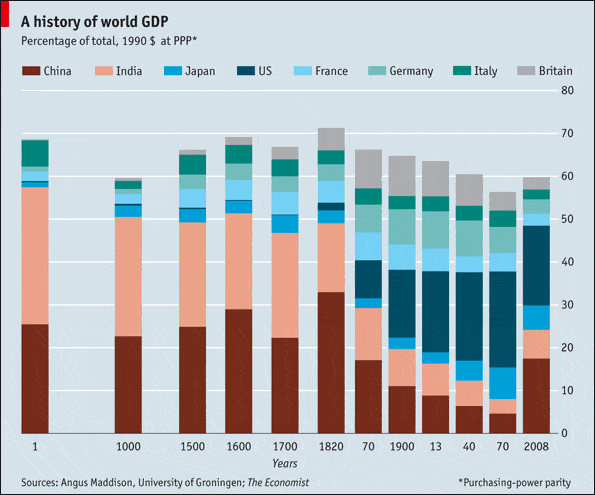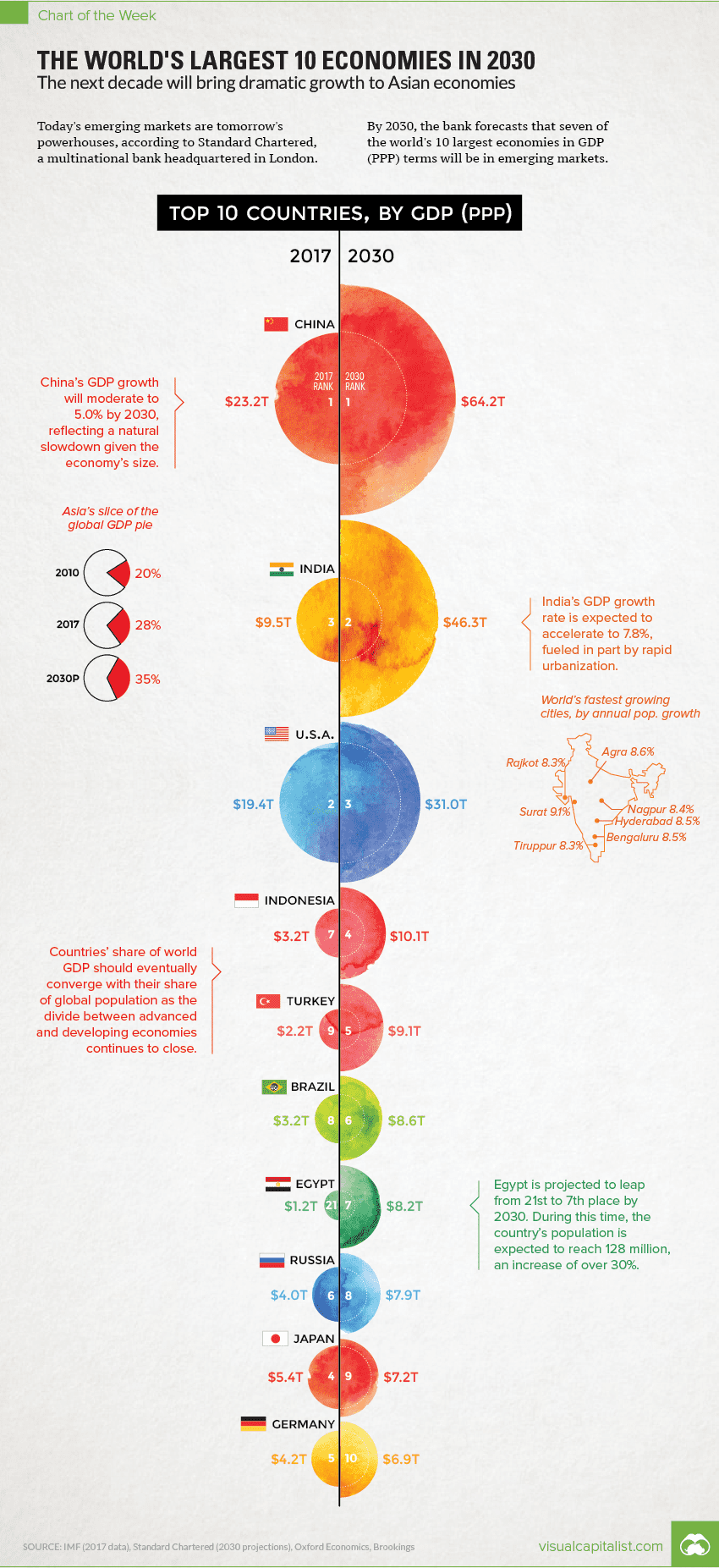Many will be surprised to hear this but, for the better part of the last 2,000 years, China and India were the world’s largest economies. Up until the Industrial Revolution, output was directly proportional to population size, so these countries naturally came on top. It wasn’t until steam engines, railroads, and mass production entered the picture that industrialized countries with much larger productivity per capita overtook the populous Asian powerhouses.
For more than a century, not long after the Civil War ended, the United States has held the crown as the world’s foremost economy. Now, history is about to reach a new turning point, with China and India set to soon reclaim their previous positions on the world economic stage.

According to Standard Chartered Bank, China will likely become the world’s largest economy at some point in 2020, overthrowing the United States. By 2030, the standings of the world’s top 10 economies will look radically different from today: the United States will claim only 3rd place, and six of the top ten countries on the list will hail from Asia.
The researchers at Standard made their projections by combining purchasing-power-parity exchange rates — so-called GDP (PPP) — and nominal gross domestic product (GDP).
[panel style=”panel-success” title=”What is GDP (PPP)” footer=”Source: Wikipedia / Purchasing Power Parity.”]Purchasing Power Parity (PPP) is measured by finding the values (in USD) of a basket of consumer goods that are present in each country (such as pineapple juice, pencils, etc.). If that basket costs $100 in the US and $200 in the United Kingdom, then the purchasing power parity exchange rate is 1:2.
For example, suppose that Japan has a higher GDP per capita ($18) than the US ($16). That means that someone in Japan would, on average, make $2 more than someone in American. However, they are not necessarily richer. Suppose that one gallon of orange juice costs $6 in Japan and only $2 in the US; then $6 in Japan exchanges to only $2 worth of US goods.
Let’s use 1 gallon of orange juice as a reference basket of goods. Based on it, we can establish a PPP index of 1 to 3 between Japan and the US. Therefore, in terms of orange juice, the Americans are richer, and in this example, the US has a GDP (PPP) of $16, unchanged since it is the reference currency. Japan, however, has GDP (PPP) of only $6 since $18 in Japan can only buy 3 gallons of orange juice, which represents only $6 of US goods.
Source: Wikipedia / Purchasing Power Parity
[/panel]
By PPP alone, China is already the world’s largest economy. On a nominal basis, however, the US is still leading the pack.
In the future, emerging markets are expected to catch up with historically-developed countries, driven by the convergence of per-capita GDP. In other words, as a country’s output starts matching the size of its population, this can mean a lot as far as hugely populated nations are concerned. For instance, Indonesia, Turkey, Brazil, and Egypt are expected to experience massive growths in their economies. To get a better idea of the bigger picture, Visual Capitalist compared Standard’s 2030 projections with the IMF’s most recent data on GDP (PPP) for 2017. It’s a bit of a case of counting apples and oranges, since the Standard assessment also includes nominal GDP in its formula, but the table gets the job done.
| Rank | Country —- | Proj. GDP (2030, PPP) —- | GDP (2017, PPP) —- | % change |
|---|---|---|---|---|
| #1 | China | $64.2 trillion | $23.2 trillion | +177% |
| #2 | India | $46.3 trillion | $9.5 trillion | +387% |
| #3 | United States | $31.0 trillion | $19.4 trillion | +60% |
| #4 | Indonesia | $10.1 trillion | $3.2 trillion | +216% |
| #5 | Turkey | $9.1 trillion | $2.2 trillion | +314% |
| #6 | Brazil | $8.6 trillion | $3.2 trillion | +169% |
| #7 | Egypt | $8.2 trillion | $1.2 trillion | +583% |
| #8 | Russia | $7.9 trillion | $4.0 trillion | +98% |
| #9 | Japan | $7.2 trillion | $5.4 trillion | +33% |
| #10 | Germany | $6.9 trillion | $4.2 trillion | +64% |
According to economists from Standard Chartered, Asian GDP will account for about 35% of the world’s GDP, up from 28% in 2018 and 20% in 2010. That’s equivalent to the combined output of the US and the European Union.



